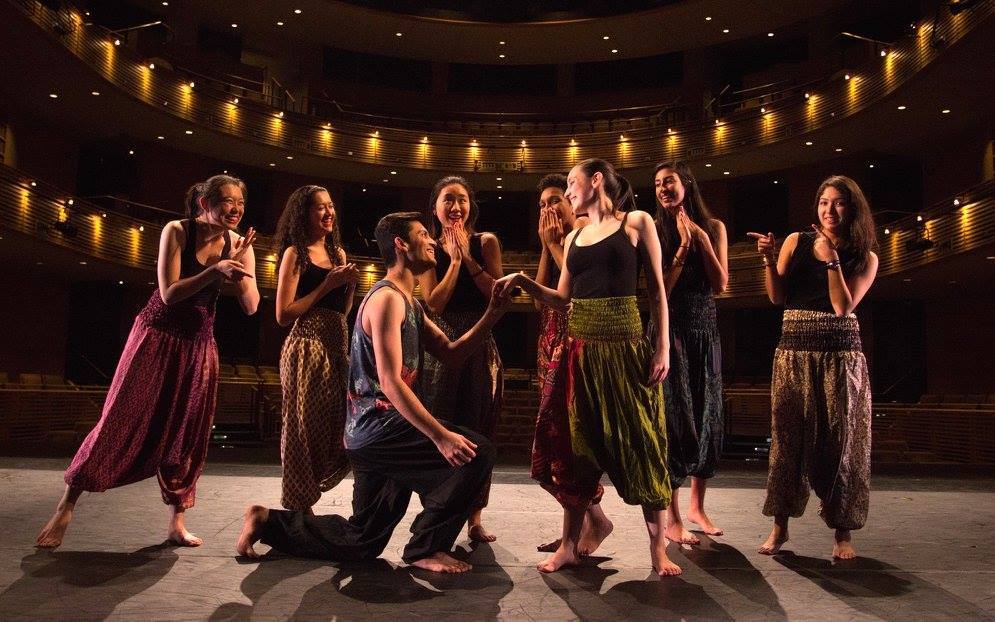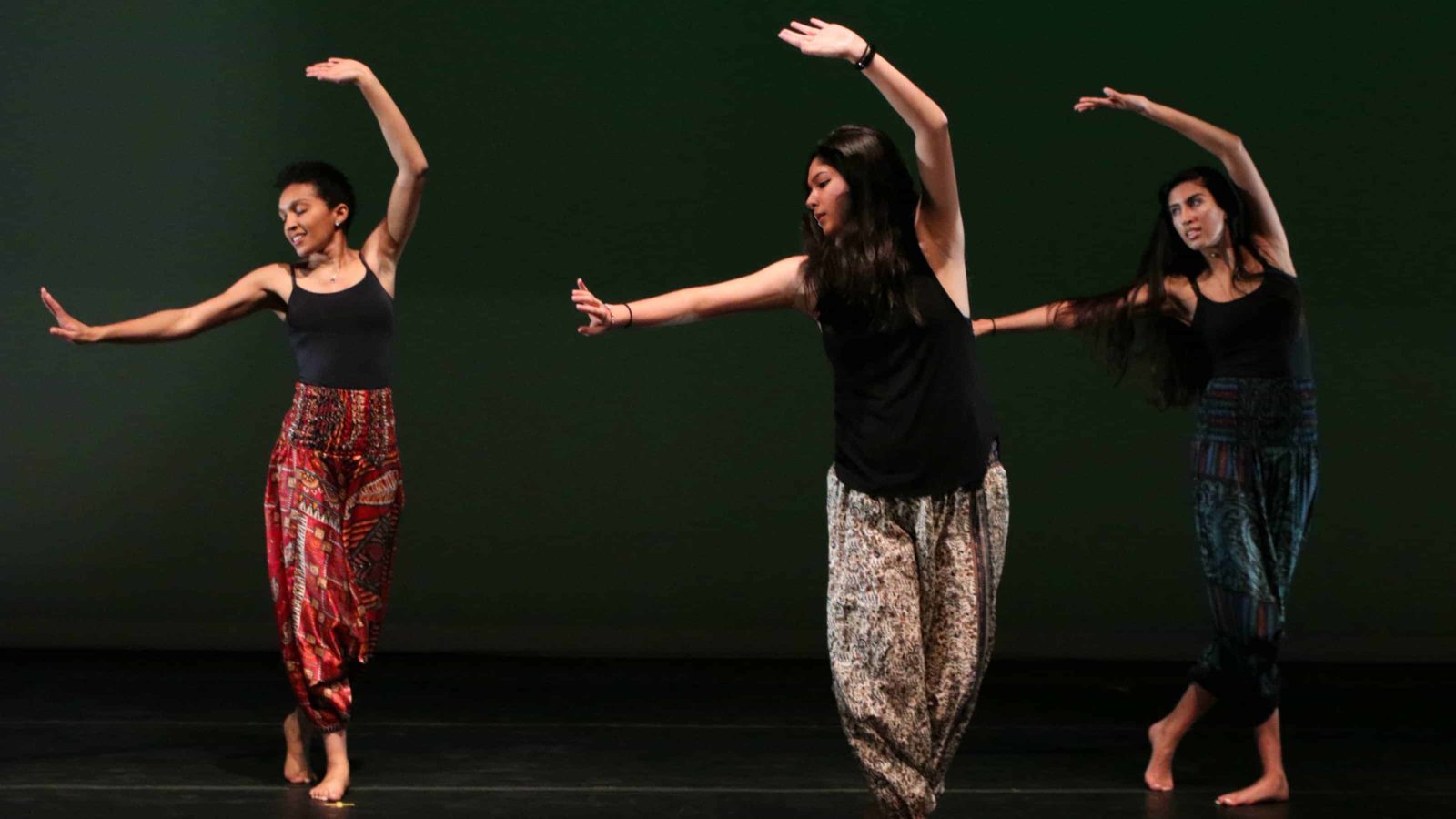The dancers are holding candles, one in each hand. They cup their hands, so the flames seem to ride on their palms. They hold out their arms and extend them overhead, spinning.
The candles are called diya, and families light them at home at the Hindu festival of Diwali to bring a small flame into the dark, like the tapers in an American church or a Menorah. On Friday and Saturday night on the Mainstage at the ’62 Center, they opened the Spring performance by Dance Dhamaka, the college’s Indian dance team.
Five members of the company have choreographed original work for the evening, including the company’s co-leaders, Williams College seniors Maria Vincent Allende, Courtney Fields and Jilly Lim, who spoke about their work in an interview at Williams.

Dance Dhamaka rehearses a number in Aik Kahani, their spring 2017 performance.
They have named the show Aik Kahani, “a story” in Hindi and in Urdu, and shaped it around an original story that Lim has largely written, and the themes in it relate directly to their own lives.
Aik Kahani follows a young woman coming to college, finding friendship and community in a company of dancers, and facing hard choices involving the people and the work she loves.
“It’s our senior drama,” Fields said.
They found music and dances they wanted to choreograph that fit naturally into the story, Allende said. And the new work blends styles from modern and classical Indian dance to hip hop, high-energy Bhangra, and the unselfconscious drama of Bollywood films.
Each of the co-leaders have two original pieces in this evening. Lim is choreographing the opening, the diya dance, called subhanallah. The name means thank God, she said, as the young woman graduates from her U.S. high school and comes to college.
Allende is setting a work to Janam Janam, a love song, and Fields’ work Pinga draws on Bhangra from the Punjab region in India with a leaping, festival energy.
They are not formally trained in many of these styles, they explained. All three were involved in dance when they were younger — ballet, modern, hip hop and jazz — and had gone on to become athletes in high school. At Williams they have learned from the company, from dancers who have visited the college and from their own research.
“Starting from last year, it’s something we gave a lot of thought to,” Allende said, “What it means for us to be the leadership of the group. None of us has a South Asian background. We are approaching a culture that is not ours with respect.”
Members of the group do have and have had that background. Uttara Partap ’13 trained in bharatanatyam, a South Indian form of dance traditionally performed in Hindu temples, and she choreographed the signature dance the company performs in every show. And this year, two members of the 12 in the company have South Asian roots or family. Moiz Rahan ’19, is an international student from Pakistan; Eman Ali ’20, choreographing work in her first year, is from Florida, and her parents have come from Pakistan.
Dance Dhamaka began more than 10 years ago with the help and guidance of Kareem Khubchandani, who became Campus Life Coordinator and Queer Life Coordinator in 2004 and then assistant director of the multicultural center from 2006 to 2008.
It began as a very small group, Lim said, giving small studio studio performances. The group has handed down boxes full of bright handmade costumes Khubchandani’s mother sent from India.
The company has grown since then, with an open structure. The dancers in the company teach each other, and more experienced dancers work with newer members. Dance Dhamaka does not audition, the co-leaders said, and that is important to all of them.
Fields has found the company welcoming, and it has given her the chance to choreograph her own work.
“I’ve met some of my closest friends here,” Lim said, “and we care about getting to know underclassmen.”
They have seen people come in who have not danced for a time, and who have struggled at the beginning, Allende said — and she has seen them grow. She has felt herself grow as well. She has become involved in dance and choreography outside the group in a tutorial and an independent study, and Dance Dhamaka gave her that confidence.
“I felt free to try,” she said. “It helped me. For a lot of people that’s the case. It’s discovering a new skill you never thought you could have.”
Her second piece in this show incorporates dandiya, wooden sticks the dancers strike together as percussion, and hip hop movements that evoke overcoming barriers, with outstretched arms and people coming through them.
All three co-leaders have found inspiration in Bollywood films as well.
They can be light or intently serious, Fields said, recalling one set during the Hindi / Muslim riots in the 1990s. They will always have musical numbers, from crowd scenes to intense duets.
“People would burst into song and dance as though it’s a way of life,” Lim said.
“There’s always a grand scene, a hundred people dancing, colors everywhere,” Allende agreed. “t’s spectacular. It feels over the top in a way that fits.”
They have also studied with visiting artists, including Shantala Shivalingappa, an internationally known dancer in the traditional style of Kuchipudi.
“It was magical,” Lim said. “We got to be up close in the studio, so she could correct our moves.”
They learned classical forms. Traditional dance often emphasizes hand positions, Allende said. She touched her fingertips together and held them apart in precise, fluid movements. And Lim held out her own hands in the “flowers,” with her fingers stretched like the tips of a leaf bud opening.
This story first ran in the Arts & Entertainment section in the Berkshire Eagle. My thanks to Arts Editor Jeffrey Borak. In the photo at the top, dancer and choreographer Courtney Fields performs. Photo by Juan Baena, courtesy of Dance Dhamaka

